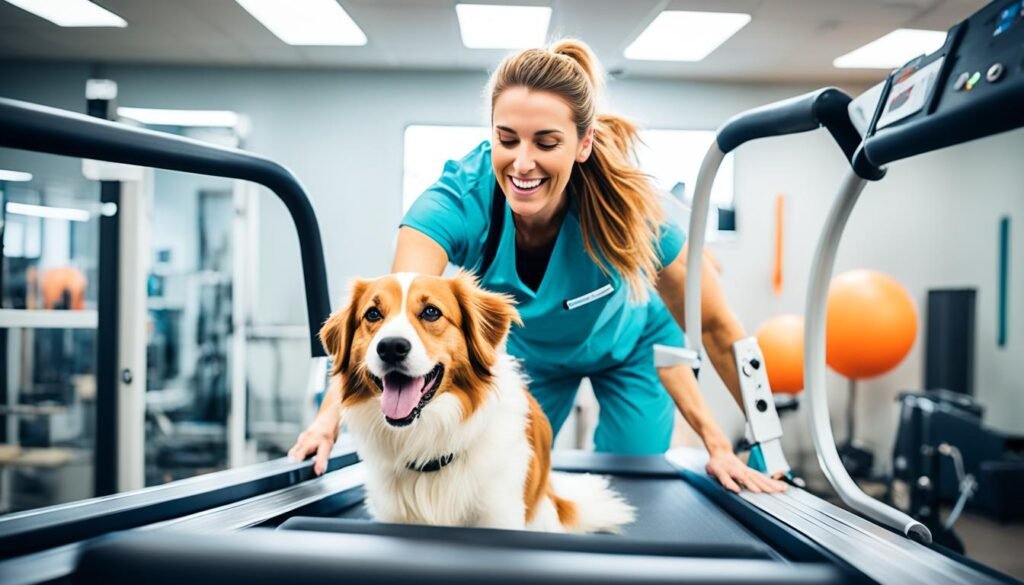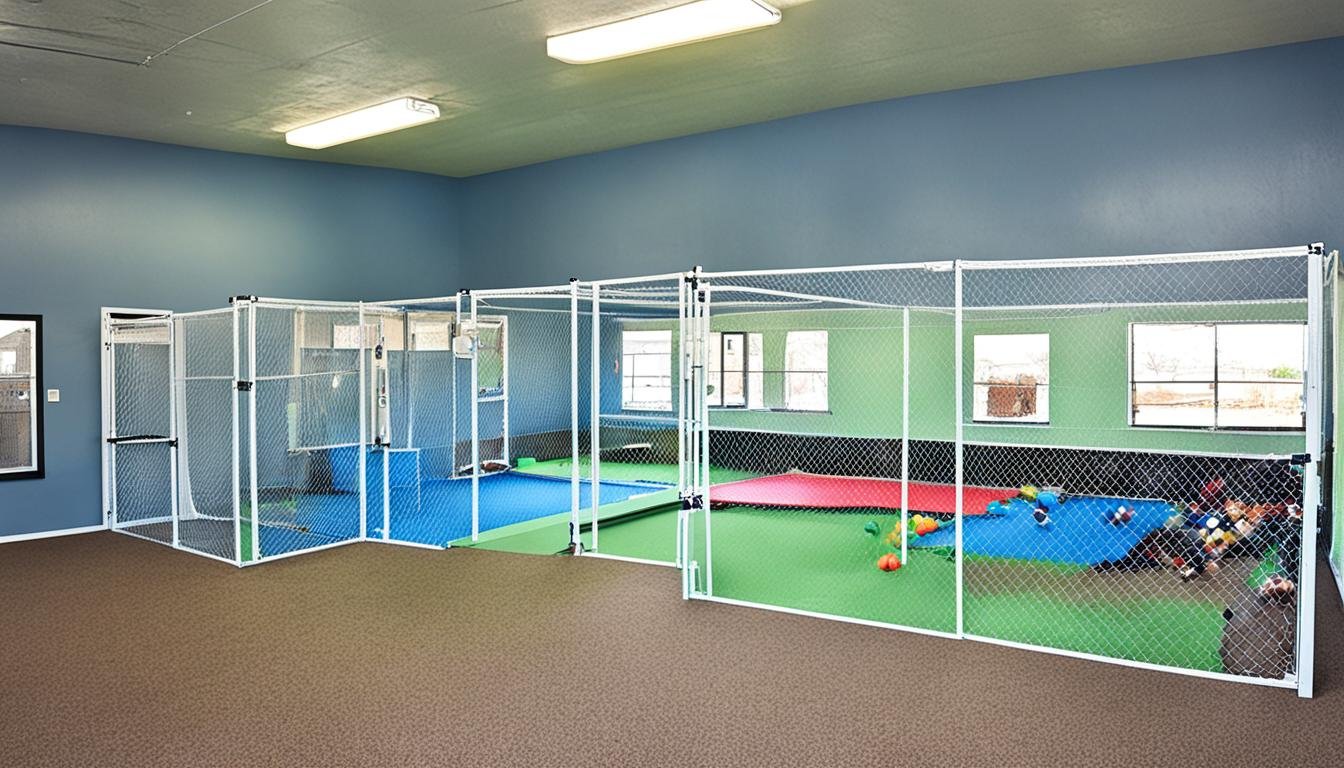Welcome to our comprehensive guide on pet physical therapy, where we will explore the numerous benefits of this specialized treatment for your furry friends. Whether your pet is recovering from an injury, managing a chronic condition, or simply in need of improved mobility, animal rehabilitation and veterinary physical therapy can play a crucial role in their overall well-being.
At [Your Pet Rehabilitation Services], we understand the importance of providing tailored therapies to address your pet’s unique needs. With our team of experienced professionals, we offer a range of services designed to enhance your pet’s quality of life and ensure a speedy recovery.
Throughout this article, we will delve into the fundamentals of pet physical therapy, uncover common conditions treated, discuss the benefits, and provide expert tips to optimize these sessions. We want to empower you with the knowledge and resources needed to make informed decisions about your pet’s care.
So let’s dive in and discover the world of pet physical therapy together! But first, to give you a glimpse of what’s to come, take a look at the image below, showcasing the joy and progress that can be achieved through this type of therapy.
Understanding Pet Physical Therapy
Pet physical therapy encompasses various specialized treatments that aim to improve the overall well-being and mobility of your furry companion. By understanding the fundamentals of pet physiotherapy, pet orthopedic therapy, and the role of animal sports medicine, you can make informed decisions about your pet’s healthcare.
Pet physiotherapy is a branch of veterinary medicine that focuses on using therapeutic exercises and techniques to enhance your pet’s physical function, reduce pain, and promote healing. It involves a range of activities tailored to the individual needs of your pet, including hydrotherapy, massage, and therapeutic exercises.
Pet orthopedic therapy is specifically designed to address musculoskeletal conditions and injuries that affect your pet’s bones, joints, muscles, and ligaments. Orthopedic therapies can involve various modalities such as manual therapy, joint mobilization, and therapeutic exercises to improve your pet’s mobility and alleviate pain.
Animal sports medicine focuses on optimizing performance and preventing injuries in active or working animals. It involves comprehensive evaluation, training programs, and specialized therapies to enhance your pet’s athletic abilities and minimize the risk of sports-related injuries.
“Pet physical therapy plays a crucial role in improving your pet’s quality of life by increasing their mobility, relieving pain, and promoting overall well-being.” – Dr. Olivia Roberts, DVM
Whether your pet is recovering from surgery, suffering from chronic conditions, or participating in sports activities, pet physical therapy can provide significant benefits. These therapies help improve range of motion, increase muscle strength, manage pain, and enhance your pet’s overall physical health.
Throughout this article, we will explore the benefits of pet physical therapy, common conditions treated, expert tips for optimizing therapy sessions, and how to find the right pet physical therapy provider. Stay tuned to learn how these specialized treatments can positively impact your furry friend’s life.
Common Conditions Treated with Pet Physical Therapy
Pet physical therapy is a valuable treatment option for a wide range of conditions that can affect our furry companions. Whether your pet is recovering from surgery, dealing with a chronic illness, or experiencing age-related mobility issues, pet physical therapy can provide much-needed relief. In this section, we will explore some common conditions that can be effectively treated with pet physical therapy, including pet mobility exercises, feline physical rehab, and canine physical therapy.
1. Pet Mobility Exercises
One of the most common reasons for seeking pet physical therapy is to improve mobility. Pets, just like humans, can experience reduced mobility due to factors such as injury, arthritis, or neurological conditions. Pet mobility exercises are designed to strengthen muscles, improve range of motion, and enhance overall mobility. These exercises may include walking on different surfaces, climbing stairs, balance training, and even swimming.
2. Feline Physical Rehab
Cats, known for their agility and flexibility, are not immune to mobility issues. Feline physical rehab focuses on addressing conditions such as arthritis, muscle weakness, and post-surgery recovery in cats. Through a combination of targeted exercises, stretching, and manual therapy, feline physical rehab aims to improve mobility and alleviate pain in our feline friends.
3. Canine Physical Therapy
Dogs, being active companions, often develop orthopedic and musculoskeletal issues that can hinder their mobility and quality of life. Canine physical therapy includes various treatment techniques such as therapeutic exercises, hydrotherapy, massage, and joint mobilizations. These therapies help dogs regain strength, reduce pain, and improve their overall well-being.
By addressing these common conditions with pet physical therapy, we can provide our pets with the necessary care and support to improve their mobility and enhance their quality of life. Let’s dive deeper into the benefits of pet physical therapy in the next section.
Benefits of Pet Physical Therapy
Discover the numerous benefits that pet physical therapy can bring to your furry friend’s life. By incorporating animal rehabilitation and pet orthopedic therapy into your pet’s healthcare routine, you can enhance their overall well-being and promote long-term health.
Pain Management
One of the key advantages of pet physical therapy is its effectiveness in managing pain. Whether your pet is recovering from surgery, suffering from arthritis, or experiencing chronic pain, rehabilitation techniques can help alleviate discomfort and improve their quality of life.
Improved Range of Motion
Pet physical therapy exercises are designed to enhance your pet’s range of motion, allowing them to move more freely and comfortably. By targeting specific muscle groups and joints, these therapies can increase flexibility and promote optimal mobility.
Enhanced Muscle Strength
Pet physical therapy programs are tailored to strengthen your pet’s muscles, promoting better balance and stability. Strengthening weak muscles not only improves mobility but also helps prevent injuries and reduces the likelihood of further health complications.
Overall Well-being
The holistic approach of pet physical therapy aims to improve your pet’s overall well-being, both physically and mentally. Through personalized rehabilitation plans, your pet can benefit from increased activity levels, boosted mood, and a higher quality of life.

With the countless benefits it offers, pet physical therapy is an essential component of your pet’s healthcare regimen. From pain management to improved muscle strength and enhanced overall well-being, animal rehabilitation and pet orthopedic therapy play a vital role in ensuring your pet’s optimal health and happiness.
Expert Tips for Pet Physical Therapy
When it comes to optimizing your pet’s physical therapy sessions, there are several expert tips to keep in mind. By following these recommendations, you can ensure that your furry friend receives the most effective and appropriate care throughout their rehabilitation journey.
1. Choose the Right Pet Rehabilitation Services
When selecting a pet rehabilitation service, it’s essential to find a provider that specializes in the specific needs of your pet. Look for facilities that offer a wide range of services, including hydrotherapy, therapeutic exercises, and pain management techniques. Additionally, consider the credentials and experience of the therapists to ensure your pet is in capable hands.
2. Consult with a Veterinary Physical Therapist
Collaborating with a qualified veterinary physical therapist is crucial for your pet’s recovery. These professionals have the expertise to assess your pet’s condition, develop customized treatment plans, and monitor their progress. By working closely with a veterinary physical therapist, you can ensure that your pet’s therapy aligns with their individual needs and goals.
3. Maintain Consistency and Patience
Consistency is key in pet physical therapy. Follow the prescribed therapy schedule diligently, ensuring that your pet attends all sessions. It’s important to be patient and understand that rehabilitation takes time. Celebrate small victories along the way and trust the process, knowing that your pet is gradually improving their strength, mobility, and overall well-being.
4. Incorporate Home Exercises
Support your pet’s progress by incorporating home exercises recommended by the physical therapist. These exercises may include stretching, range of motion activities, or low-impact movements. By engaging in these exercises at home, you can enhance the benefits of the therapy sessions and actively contribute to your pet’s recovery.
5. Monitor and Communicate
Regularly monitor your pet’s progress and observe any changes in their behavior or physical condition. If you notice any concerns or have questions, don’t hesitate to communicate with your veterinary physical therapist. They can provide guidance, offer solutions, and adjust the therapy plan if necessary. Open communication is vital to ensure the best possible outcome for your pet.

By following these expert tips, you can optimize your pet’s physical therapy sessions and support their recovery journey. Remember, pet rehabilitation services and veterinary physical therapy play an essential role in enhancing your pet’s quality of life, so make informed choices and prioritize their well-being.
Finding the Right Pet Physical Therapy Provider
When it comes to ensuring the well-being of your furry friend, finding the right pet physical therapy provider is crucial. Whether your pet requires rehabilitation after surgery or needs assistance with mobility issues, selecting a qualified professional in animal rehabilitation and veterinary physical therapy is essential for optimal care.
Pet rehabilitation services encompass a range of therapies, including hydrotherapy, therapeutic exercises, and massage, designed to improve your pet’s overall quality of life. By partnering with a trusted provider, you can rest assured knowing that your pet will receive personalized attention and specialized treatments tailored to their specific needs.
To find a reliable pet physical therapy provider, consider the following factors: experience and qualifications of the professionals, access to state-of-the-art facilities and equipment, and a comprehensive understanding of animal rehabilitation techniques. It is also important to choose a provider who fosters a compassionate and nurturing environment to ensure your pet feels safe and comfortable during the therapy sessions.
By investing time in research and making informed decisions, you can find a pet physical therapy provider who shares your commitment to your pet’s well-being. Together with the expertise and guidance of a reputable provider, you can embark on a journey of healing and recovery, as your beloved companion gains strength, mobility, and a better quality of life.




